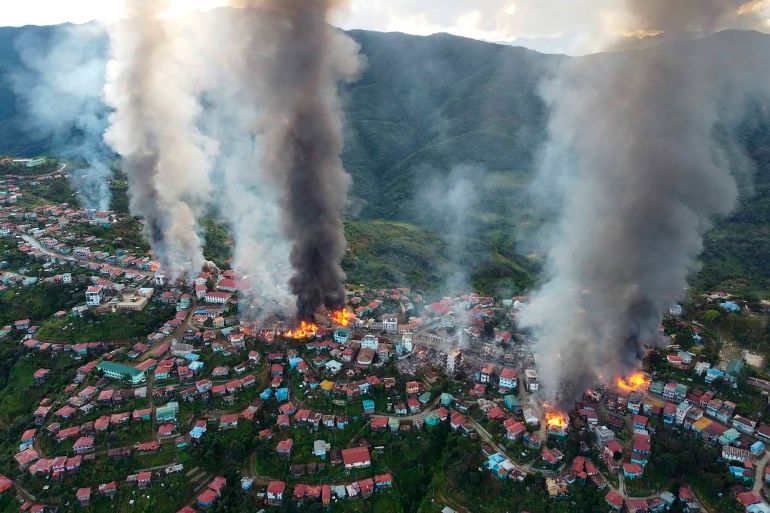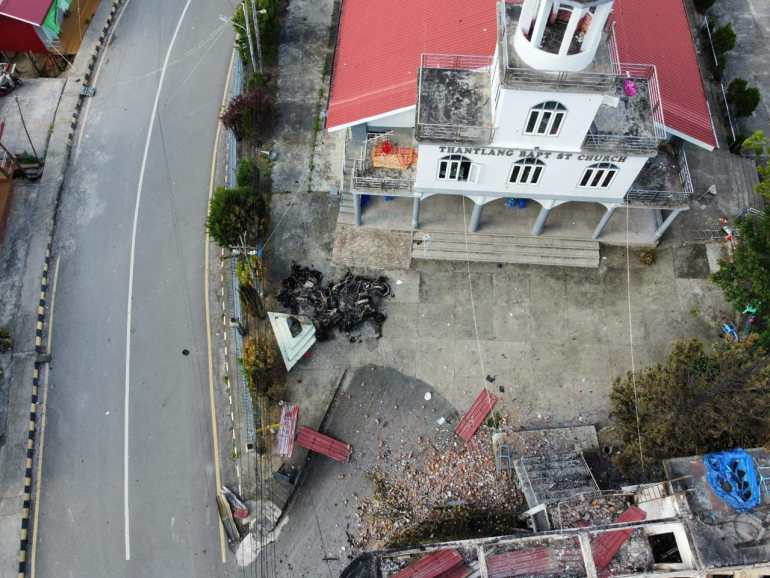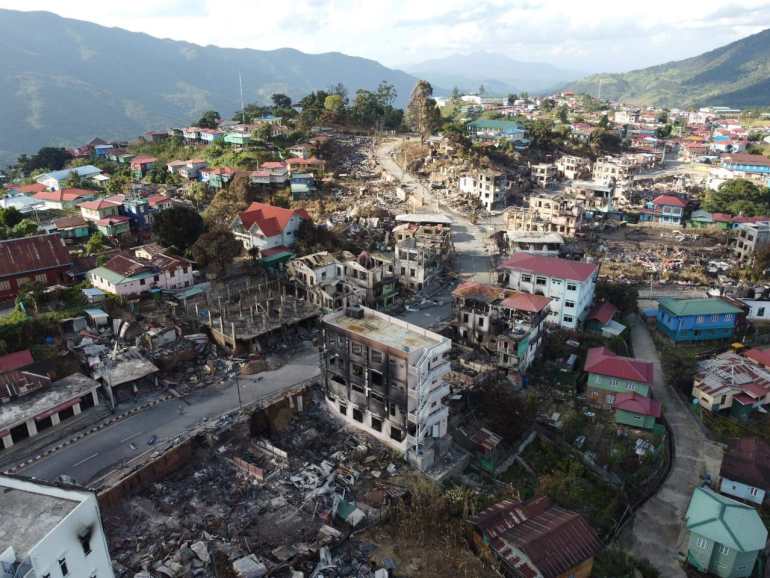Scramble for evidence after attack in northwestern Myanmar
Soldiers’ presence, internet shutdown hamper efforts to gather details of military assault in Chin state that destroyed dozens of homes.

Thang Biak discovered his house in Myanmar’s northwestern Chin State had burned down from watching the television news in neighbouring India.
He had fled Thantlang, a hilltop town of roughly 8,000 people, with his three sons and other residents on September 14, crossing into Mizoram two weeks later.
Keep reading
list of 4 itemsRights groups seek UN intervention over Myanmar army offensives
Myanmar court denies bail for US journalist, adds new charge
Myanmar military shells restive town, destroying dozens of homes
“When we fled, we couldn’t bring anything. Now all of our property has been destroyed,” said Thang Biak, for whom Al Jazeera has used a pseudonym due to concerns of military reprisals. “When I learned that my house had burned, I was so depressed that I couldn’t sleep or eat,” he added.
His home was one of more than 160 houses and two church buildings in Thantlang that were burned down on October 29, as the military intensified its operations to root out the civilian armed groups that have emerged across the country since the coup on February 1.
Governments, rights organisations and civil society groups have condemned the military for the destruction in Thantlang and have demanded it be held accountable.
More than 500 organisations, including Human Rights Watch, signed a statement last week calling on the United Nations Security Council to act urgently to “end [the] Myanmar junta’s campaign of terror.”
The United States said the incident “lays bare the regime’s complete disregard for the lives and welfare of the people of Burma,” and said the attacks “underscore the urgent need for the international community to hold the Burmese military accountable”.
But as calls for military accountability grow, those collecting and sharing evidence of what happened in Thantlang face numerous risks and obstacles, including fear of arrest or retaliation and an ongoing internet shutdown. Local sources told Al Jazeera that they have also been unable to identify witnesses because Thantlang’s residents had fled earlier waves of violence in September, and the town has been occupied by soldiers.
“We journalists could not go to document ourselves … We could not get [sufficient] evidence and communication has been cut off,” said Salai Zing, who works for a Chin State-based media outlet and who requested Al Jazeera call him by his nickname.

Before the coup, the remote, mountainous area along Myanmar’s northwestern border with India had not seen fighting for years. Although the area hosts the Chin National Front, an ethnic armed organisation established in 1988, the group had signed a Nationwide Ceasefire Agreement in 2015, and had not clashed with the military since then.
Since May, however, the country’s northwest has been a stronghold of armed resistance, hosting several of the country’s fiercest anti-coup civilian defence forces, which have at times launched coordinated attacks with the Chin National Front’s armed wing against the military.
In response, the military has shelled residential areas and restricted the transport of food and aid, following tactics it has used for decades to destroy the support base for ethnic armed organisations.
More than 37,000 people from Chin State and neighbouring Sagaing and Magway regions have become internally displaced since May and a further 15,000 have fled to India, according to the UN, which says 223,000 people have been displaced across the country since the coup.
Escalating violence
While the military’s attacks may seek to destroy resistance movements, they appear to have had the opposite effect. On September 7, the National Unity Government, operating in exile, announced a “defensive war” on the generals and called on people across the country to “revolt” against dictatorship.
In Thantlang, clashes began accelerating days later, and on September 18, resistance forces claimed to have killed 30 soldiers. The same day, the military bombarded the town with artillery fire, burning down 18 buildings. A pastor rushing to quell the flames was shot dead, and when locals retrieved the body, his ring finger had been cut off.
Over the following weeks, soldiers and police occupied the town. Four people were shot, two fatally, while they were attempting to retrieve belongings or deliver food to those left behind, according to the Chin Human Rights Organization.
On October 8, local media outlet The Irrawaddy reported that the military had deployed about 3,000 troops to Chin, Sagaing and Magway, while the UN High Commissioner for Human Rights described “alarming reports” indicating a “substantial deployment of heavy weapons and troops” in several townships in these areas.
The chairperson of the Chinland Defence Force (CDF) – Thantlang, who goes by the nickname Romoe Lian, told Al Jazeera that on the morning of October 29, CDF fighters armed with single-shot hunting rifles known as tumee guns moved around in the surrounding forest to protect the town from looting. When two soldiers broke into a local home, CDF fighters fired three shots, killing one soldier. Military troops retaliated with artillery and gunfire, and the CDF retreated.
Drone footage taken by the CDF that morning shows an armed unit entering buildings in the town; the same buildings burned down after the camera had stopped filming. Photos and videos taken from a distance later that day show multiple distinct plumes of smoke, indicating that several fires started independently of each other.
Military Spokesperson Zaw Min Tun told state media that soldiers and police in Thantlang were patrolling “for the security of the residents” on the morning of October 29, when resistance fighters set off three homemade bombs and “fired with small weapons”. After security forces conducted counter-attacks, he said, the resistance fighters retreated and “set fire on four homes so that the security members could not follow them”.
The situation evokes flashbacks to the military’s “clearance operations” against the mostly-Muslim Rohingya in Rakhine State in 2017, when soldiers torched hundreds of villages and 730,000 people fled to Bangladesh.
Then, the Aung San Suu Kyi-led government accused “Muslim people” of starting the fires while refusing independent access to journalists and human rights monitors, and declining to cooperate with a fact-finding mission appointed by the UN Human Rights Council. The crackdown is the subject of a genocide case brought by the Gambia.
Salai Dokhar, an independent politician from Thantlang and an anti-coup activist who was released from four months in prison at the end of June, told Al Jazeera that it was impossible that local resistance groups had started the recent fires.
“Whether poor or rich, we [Chin People] care about good houses. For Chin people, a house is the most valuable of all possessions,” he said. “It does not make sense that we are destroying our houses that cost millions [of kyats] to build and the churches in which we worship … We are not that vulgar.”
The Chin Human Rights Organization, which has played a leading role in documenting the military’s abuses in Chin State since the coup, has said the fires were caused by incendiary rockets which the military fired into the town.
The organisation’s deputy executive director, Salai Za Uk Ling, told Al Jazeera that the fires were “deliberate and part of the [military’s] scorched earth campaign … under which soldiers on the ground are authorised to engage in activities designed to destroy lives and properties at will”.
🔥Thantlang Fires🔥
We were sent this video today claiming:
✅Thantlang is on fire again
🔍Fires started by soldiers from LIB 269/LIB 222/LID 11We investigate both claims and show how we are able rapidly to verify the first but need more info on the second.
More👇#Myanmar pic.twitter.com/pBIoc0t3y3
— Myanmar Witness (@MyanmarWitness) October 29, 2021
The primary photographic and video evidence, published from the morning of October 29, is the CDF’s drone footage, which does not capture the moment the fires ignited. Only one witness account, a radio interview with Voice of America, has so far been published.
Those documenting the incident say they have encountered numerous difficulties in collecting and verifying information.
Challenges of verification
Since the coup, the military has arrested at least 126 journalists, expanded its use of online surveillance, and set up road checkpoints where security forces routinely search through electronic devices. Some people have also been arrested for posting footage of human rights incidents on social media.
Salai Zing, the local journalist, told Al Jazeera that his team has significantly scaled back its activities since March for fear of being targeted. “We closed our office and took down the signboard … We asked our journalists to live like normal citizens and told them not to carry cameras,” he said.
Not only is his team unable to send reporters to the field, but they face an internet shutdown that has been imposed in 24 townships across Myanmar’s northwest, including Thantlang, since September.
” It became very hard for journalists to get data and information, and when we investigate, there are many third parties who [passed] it from person to person,” he said.
Myanmar Witness, a nonprofit organisation that independently collects, verifies and stores evidence of possible human rights abuses, including to support investigations into violations of international law, also faces a scarcity of evidence surrounding the Thantlang fires, according to its head of investigations Benjamin Strick.
To verify the details of an incident, the organisation compares multiple pieces of evidence, including social media posts and those it receives from direct submissions. It has so far attributed 37 percent of the 1,187 pieces of media it has analysed since the coup to Myanmar security forces, but has not yet made an attribution regarding the October 29 fires in Thantlang.
“Our level of attribution runs a lot deeper to ensure that what we’re seeing are actually soldiers in uniforms with specific patches on, with specific ranks and insignias, and before we get to that level, we cannot attribute, “Strick said.
The most significant barrier to documentation, he said, has been limited internet and telecommunications access, which “has trickled down to a result of less footage and less people posting online about what’s happening”.
On a national level, there are signs of progress, however.
On Friday, the Independent Investigative Mechanism for Myanmar, (IIMM), a body established by the UN Human Rights Council, announced that it had collected more than 1.5 million pieces of evidence since the coup, and that preliminary evidence demonstrates a “widespread and systematic attack” on civilians which amounts to crimes against humanity.

Established in 2018 by the UN Human Rights Council, the mechanism seeks to collect, consolidate, preserve and analyse evidence of serious international crimes and violations of international law committed in Myanmar since 2011 in order to hold those responsible to account in regional, national and international tribunals.
Strick, whose organisation shares evidence with the IIMM, said that in spite of the ongoing obstacles, he is hopeful that organisations will find a way to document, preserve and verify reports of human rights abuses so that evidence “can be used not just next week or next month, but in five, 10, 15 or 20 years time when there is judicial action and investigations”.